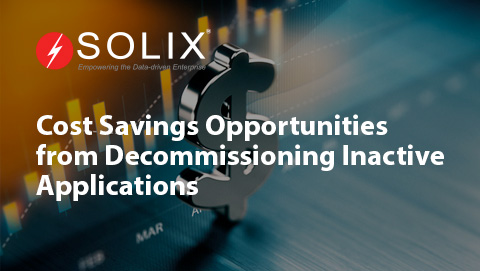
Application Retirement Implementation
When organizations find themselves holding onto legacy applications that no longer serve their strategic goals, the question becomes how do we implement an effective application retirement strategy Application retirement implementation encompasses various steps, from assessing the applications in use to transferring critical data. In essence, its about ensuring that you shut down applications gracefully while safeguarding valuable heritage data and retaining compliance. Lets explore how to execute this process smoothly and efficiently.
As someone who has guided numerous organizations through this complex process, Ive witnessed firsthand the importance of having a structured approach to application retirement implementation. It isnt as simple as just discontinuing software; it requires planning, transparency, and an understanding of the long-term implications of your decisions. Lets dive deeper into what application retirement entails and how you can implement it successfully.
Understanding Application Retirement Implementation
At its core, application retirement implementation refers to the planned decommissioning of software applications that are no longer required or relevant to an organizations operational needs. Many businesses find themselves grappling with outdated software, leading to increased costs, security risks, and inefficiencies. Additionally, legacy applications may pose compliance and data governance challenges.
The first step is to conduct a thorough assessment of your existing applications. List all current systems and evaluate their usage, performance, and alignment with business goals. Understanding the strengths and weaknesses of each application is crucial in determining which ones to retire. For example, if an application has not been utilized in the past year, it might be a prime candidate for retirement.
Reasons for Application Retirement
Businesses often question the timing of application retirement implementation. Common reasons include
- Cost Efficiency Maintaining outdated software can drain resources.
- Security Risks Old applications often lack the necessary updates, putting your data at risk.
- Integration Challenges New applications might not integrate well with legacy systems, causing inefficiencies.
- Compliance Issues Regulatory changes may require the retirement of specific applications to meet data protection and privacy standards.
By understanding these reasons, organizations can adopt a more proactive stance in their software management approach, enhancing operational efficiency while addressing potential risks.
Steps to Implement Application Retirement
Successful application retirement implementation involves several key steps
1. Assessment and Planning
Begin by evaluating your portfolio of applications to identify which ones could be retired. This assessment phase is crucial and should be comprehensive. Engage stakeholders to gather insights into application usage, business value, and potential data governance issues. From here, you can create a retirement plan to guide your team.
2. Data Mitigation
Next, consider what data resides within the applications earmarked for retirement. Its important to ensure that critical data is migrated to a new system or archived in a compliant manner. Failure to handle this properly can result in lost knowledge and hinder organizational performance in the long run. Solutions such as the Solix Cloud Data Archiving can assist in securely storing and managing your legacy data.
3. Communication
Communicating the application retirement decision is vital for transparency. Ensure that all affected employees are informed and understand the timeline and processes involved. This open communication fosters a smoother transition and eases any concerns that teams may have over lost functionality.
4. Implementation
Once youve prepared, its time to execute the retirement process. This includes shutting down the application, monitoring the transition, and ensuring data has been appropriately preserved. Employ tactics such as phased rollouts or pilot testing to minimize disruption.
5. Review and Optimize
Post-implementation, its crucial to assess the outcomes of the application retirement. This review should measure success against the initial objectives set forth during the planning stage. Learnings from this process can shape future application management strategies, enabling continuous improvement.
Practical Scenario A Successful Application Retirement
I recall a mid-sized company that relied heavily on a customer relationship management (CRM) system from over a decade ago. The software was cumbersome, expensive, and did not support mobile devices, which stymied sales agents. When approached, the organization recognized the need for application retirement implementation.
After conducting a comprehensive evaluation that involved IT and sales, they decided to retire the legacy CRM. By utilizing a phased approach to gradually migrate data to a modern, cloud-based CRM solution, the company saw a remarkable improvement in operational efficiency. Their sales team reported being 50% more productive, and the risk associated with managing outdated software decreased significantly.
Connect with Solix for Expert Guidance
Implementing application retirement can be daunting, but having the right partner makes all the difference. At Solix, we provide solutions that can simplify the process, such as the Solix Application Retirement ServiceOur expertise and tailored solutions help ensure that your legacy applications are retired efficiently while retaining compliance with regulations. If youre ready to navigate this critical transition, dont hesitate to reach out. You can call us at 1.888.GO.SOLIX (1-888-467-6549) or get in touch through our contact page
Wrap-Up
In wrap-Up, application retirement implementation is not a task to be taken lightly, but with careful planning and execution, organizations can transition smoothly. By understanding the implications, assessing your applications, and following a structured approach, you can minimize risks and maximize benefits. This ensures that your organization can focus on innovation while managing operational costs effectively.
About the Author
Elva is a technology consultant with extensive experience in application retirement implementation. She has helped numerous organizations assess their software landscapes and transition to modern solutions, making her insights valuable for navigating the complexities of application management.
The views expressed in this blog post are the authors own and do not represent the official position of Solix.
Sign up now on the right for a chance to WIN $100 today! Our giveaway ends soon‚ dont miss out! Limited time offer! Enter on right to claim your $100 reward before its too late!
DISCLAIMER: THE CONTENT, VIEWS, AND OPINIONS EXPRESSED IN THIS BLOG ARE SOLELY THOSE OF THE AUTHOR(S) AND DO NOT REFLECT THE OFFICIAL POLICY OR POSITION OF SOLIX TECHNOLOGIES, INC., ITS AFFILIATES, OR PARTNERS. THIS BLOG IS OPERATED INDEPENDENTLY AND IS NOT REVIEWED OR ENDORSED BY SOLIX TECHNOLOGIES, INC. IN AN OFFICIAL CAPACITY. ALL THIRD-PARTY TRADEMARKS, LOGOS, AND COPYRIGHTED MATERIALS REFERENCED HEREIN ARE THE PROPERTY OF THEIR RESPECTIVE OWNERS. ANY USE IS STRICTLY FOR IDENTIFICATION, COMMENTARY, OR EDUCATIONAL PURPOSES UNDER THE DOCTRINE OF FAIR USE (U.S. COPYRIGHT ACT § 107 AND INTERNATIONAL EQUIVALENTS). NO SPONSORSHIP, ENDORSEMENT, OR AFFILIATION WITH SOLIX TECHNOLOGIES, INC. IS IMPLIED. CONTENT IS PROVIDED "AS-IS" WITHOUT WARRANTIES OF ACCURACY, COMPLETENESS, OR FITNESS FOR ANY PURPOSE. SOLIX TECHNOLOGIES, INC. DISCLAIMS ALL LIABILITY FOR ACTIONS TAKEN BASED ON THIS MATERIAL. READERS ASSUME FULL RESPONSIBILITY FOR THEIR USE OF THIS INFORMATION. SOLIX RESPECTS INTELLECTUAL PROPERTY RIGHTS. TO SUBMIT A DMCA TAKEDOWN REQUEST, EMAIL INFO@SOLIX.COM WITH: (1) IDENTIFICATION OF THE WORK, (2) THE INFRINGING MATERIAL’S URL, (3) YOUR CONTACT DETAILS, AND (4) A STATEMENT OF GOOD FAITH. VALID CLAIMS WILL RECEIVE PROMPT ATTENTION. BY ACCESSING THIS BLOG, YOU AGREE TO THIS DISCLAIMER AND OUR TERMS OF USE. THIS AGREEMENT IS GOVERNED BY THE LAWS OF CALIFORNIA.
-
-
-
White Paper
Cost Savings Opportunities from Decommissioning Inactive Applications
Download White Paper -




